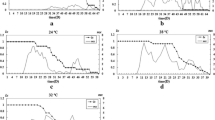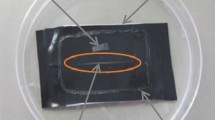Abstract
The developmental rate of immature stages and the reproduction of adults of Tyrophagus putrescentiae (Schrank), T. neiswanderi Johnston and Bruce and Acarus farris (Oudemans) were examined at 70, 80 and 90% r.h. and a constant temperature of 25°C. At 70% r.h., T. putrescentiae and A. farris immature stages failed to reach the protonymph stage as 100% of the larvae died, whereas T. neiswanderi was able to complete development. The developmental time of all immature stages for the three species was significantly increased as relative humidity was reduced. The mobile stages were particularly susceptible, as the time needed to complete their development at lower relative humidities suffered greater increases than the egg stage. At 70% r.h., T. putrescentiae and A. farris were not able to lay eggs and only 24% of T. neiswanderi pairs were fertile. The reproductive parameters of the three species at the relative humidities at which they were able to lay eggs showed significant differences, except for the percentage of fertile mating at 80 and 90% r.h. As relative humidity increased, preoviposition period was reduced and fecundity and daily fecundity was increased, whereas the oviposition period showed different patterns for the three species. The intrinsic rate of increase (r m ) of T. neiswanderi at 70% r.h. was negative indicating that, at these conditions, mite populations of this species will diminish until they disappear. As relative humidity increased from 80 to 90% r.h. this parameter was almost twofold for both Tyrophagus species. The r m obtained for A. farris at 90% r.h. was similar to that of T. neiswanderi at the same humidity while at 80% r.h. it was very small so that the population doubling time was more than 84 days. The influence of relative humidity on biology of these mites and its practical application as control measure are discussed.

Similar content being viewed by others
References
Arlian LG (1992) Water balance and humidity requirements of house dust mites. Exp Appl Acarol 16:15–35
Arlian LG, Veselica MM (1981) Effect of temperature on the equilibrium body water mass in the mite Dermatophagoides farinae. Physiol Zool 54:393–399
Arlian LG, Confer PD, Rapp CM, Vyszenski-Moher DL, Chang JCS (1998) Population dynamics of the house dust mites Dermatophagoides farinae, D. pteronyssinus, and Euroglyphus maynei (Acari: Pyroglyphidae) at specific relative humidities. J Med Entomol 35(1):46–53
Arlian LG, Neal JS, Vyszenski-Moher DL (1999a) Fluctuating hydrating and dehydrating relative humidities effects on the life cycle of Dermatophagoides farinae (Acari: Pyroglyphidae). J Med Entomol 36(4):457–461
Arlian LG, Neal JS, Vyszenski-Moher DL (1999b) Reducing relative humidity to control the house dust mite Dermatophagoides farinae. J Allergy Clin Immunol 104(4):852–856
Arlian LG, Neal JS, Morgan MS, Vyszenski-Moher DL, Rapp CM, Alexander AK (2001) Reducing relative humidity is a practical way to control dust mites and their allergens in homes in temperate climates. J Allergy Clin Immunol 107(1):99–104
Arnau J, Guerrero L (1994) Physical methods of controlling mites in dry-cured ham. Fleischwirtschaft 74:1311–1313
Barker PS (1967) The effects of high humidity and different temperatures on the biology of Tyrophagus putrescentiae (Schrank) (Acarina: Tyrogliphidae). Can J Zool 45:91–96
Birch LC (1948) The intrinsic rate of natural increase of an insect population. J Anim Ecol 17:15–26
Colloff MJ (1987) Effects of temperature and relative humidity on development times and mortality of eggs from laboratory and wild populations of the European house-dust mite Dermatophagoides pteronyssinus (Acari: Pyroglyphidae). Exp Appl Acarol 3:279–289
Cunnington AM (1965) Physical limits for complete development of the grain mite, Acarus siro L. (Acarina, Acaridae), in relation to its world distribution. J Appl Ecol 2(2):295–306
Cunnington AM (1969) Physical limits for complete development of the copra mite, Tyrophagus putrescentiae (Schrank) (Acarina, Acaridae). In: Evans GO (ed) Proceedings of the 2nd international congress of acarology 1967. Akadémiai Kiadó, Budapest, pp 241–248
Cunnington AM (1976) The effect of physical conditions on the development and increase of some important storage mites. Ann Appl Biol 82(1):175–178
Cunnington AM (1985) Factors affecting oviposition and fecundity in the grain mite Acarus siro L. (Acarina: Acaridae), especially temperature and relative humidity. Exp Appl Acarol 1:327–344
Cutcher J (1973) The critical equilibrium activity of non-feeding Tyrophagus putrescentiae. Ann Entomol Soc Am 66(3):609–611
Danielsen C, Stengard Hansen L, Nachman G, Herling C (2004) The influence of temperature and relative humidity on the development of Lepidoglyphus destructor (Acari: Glycyphagidae) and its production of allergens: a laboratory experiment. Exp Appl Acarol 32:151–170
Evans GO (1992) Principles of acarology. CAB International, Wallingford
Hughes AM (1976) The mites of stored food and houses. Tech Bull Minist Agric Fish Food 9:1–400
Meyer JS, Ingersoll CG, McDonall LL, Boyce MS (1986) Estimating uncertainty in population growth rates: jacknife vs. bootstrap techniques. Ecology 67(5):1156–1166
Nangia N, ChannaBasavanna GP (1989) Influence of temperature and relative humidity on the development of Tyrolichus casei (Astigmata: Acaridae). In: ChannaBasavanna GP, Viraktamath CA (eds) Progress in acarology, vol 2. EJ Brill, Leiden, pp 259–264
Pike AJ, Cunningham MJ, Lester PJ (2005) Development of Dermatophagoides pteronyssinus (Acari: Pyroglyphidae) at constant and simultaneously fluctuating temperature and humidity conditions. J Med Entomol 42(3):266–269
Rivard I (1958a) A technique for rearing Tyroglyphid mites on mould cultures. Can Entomol 90:146–147
Rivard I (1958b) Influence of humidity on mortality and rate of development of immature stages of the grain-infesting mite Tyrophagus castellanii reared on mould cultures. Can Entomol 90:721–724
Rivard I (1959) Influence of humidity on longevity, fecundity and rate of increase of the grain infesting mite Tyrophagus castellanii (Acarina: Acaridae) reared on mould cultures. Can Entomol 91:32–35
Rivard I (1961) Influence of temperature and humidity on mortality and rate of development of immature stages of the mite Tyrophagus putrescentiae (Schrank) (Acarina: Acaridae) reared on mold cultures. Can J Zool 39:419–426
Sánchez-Ramos I, Castañera P (2001) Acaricidal activity of natural monoterpenes on Tyrophagus putrescentiae (Schrank), a mite of stored food. J Stored Prod Res 37:93–101
Sánchez-Ramos I, Álvarez-Alfageme F, Castañera P (2007) Development and survival of the cheese mites, Acarus farris and Tyrophagus neiswanderi (Acari: Acaridae), at constant temperatures and 90% relative humidity. J Stored Prod Res 43:64–72
Taberner A, Castañera P, Silvestre E, Dopazo J (1993) Estimation of the intrinsic rate of natural increase and its error by both algebraic and resampling approaches. Cabios 9(5):535–540
Wharton GW, Furumizo RT (1977) Supracoxal gland secretions as a source of fresh water for Acaridei. Acarologia 19(1):112–116
Wharton RH, Duke KM, Epstein HM (1979) Water and the physiology of house dust mites. In: Rodríguez JG (ed) Recent advances in acarology. Academic, New York, pp 325–335
Witalinski W (1993) Egg shells in mites: vitelline envelope and chorion in Acaridida (Acari). Exp Appl Acarol 17:321–344
Zdarkova E (1991) Stored product acarology. In: Dusbábek F, Bukva V (eds) Modern acarology. Academia, Prague, pp 211–218
Acknowledgments
The research reported in the present paper was funded by the CAPSA and the Ministry of Science & Technology (project nos. PTR95.0612.OP and AGL2001-1652-CO2). We are grateful to Philippe Balbarie (CAPSA) for his assistance in mite sampling.
Author information
Authors and Affiliations
Corresponding author
Rights and permissions
About this article
Cite this article
Sánchez-Ramos, I., Álvarez-Alfageme, F. & Castañera, P. Effects of relative humidity on development, fecundity and survival of three storage mites. Exp Appl Acarol 41, 87–100 (2007). https://doi.org/10.1007/s10493-007-9052-7
Received:
Accepted:
Published:
Issue Date:
DOI: https://doi.org/10.1007/s10493-007-9052-7




